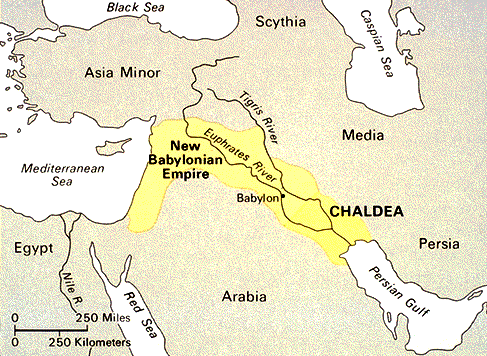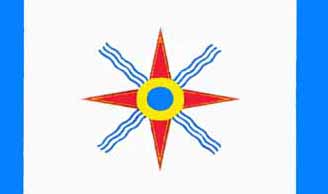



Chaldea also spelled Chaldaea, Assyrian Kaldu, Babylonian Kasdu, Hebrew Kasddim (modern southern Iraq) is frequently mentioned in the Old Testament.
�C�h�a�l�d�e�a�,� �"�t�h�e� �C�h�a�l�d�e�e�s�"� �o�f� �t�h�e� �K�J�V� �O�l�d� �T�e�s�t�a�m�e�n�t�,� �w�a�s� �a� �H�e�l�l�e�n�i�s�t�i�c� �d�e�s�i�g�n�a�t�i�o�n� �f�o�r� �a� �p�a�r�t� �o�f� �B�a�b�y�l�o�n�i�a�.� �O�n�e� �e�a�r�l�y� �s�u�c�h� �r�e�f�e�r�e�n�c�e� �i�s� �t�o� �t�h�e� �i�m�p�e�n�d�i�n�g� �s�a�c�k� �o�f� �J�e�r�u�s�a�l�e�m� �b�y� �N�e�b�u�c�h�a�d�n�e�z�z�a�r� �I�I� �(�H�a�b�a�k�k�u�k� �1�:�6�)�.� �T�h�e� �H�e�b�r�e�w� �n�a�m�e� �f�o�r� �a�n�c�i�e�n�t� �C�h�a�l�d�e�a�n�s� �w�a�s� �K�a�s�d�i�m��.�
T�h�e� �B�o�o�k� �o�f� �G�e�n�e�s�i�s� �n�a�r�r�a�t�i�v�e� �o�f� �A�b�r�a�h�a�m� �p�l�a�c�e�s� �h�i�m� �a�t� �U�r�,� �w�h�i�c�h� �w�a�s� �a�t� �a� �l�a�t�e�r� �t�i�m�e� �t�h�e� �c�o�u�n�t�r�y� �o�f� �t�h�e� �k�a�s�d�i�m - �t�h�e� �"�C�h�a�l�d�e�a�n�s�"�,� �o�r� �j�u�s�t� �p�o�s�s�i�b�l�y� �t�h�e� �"�K�a�s�s�i�t�e�s�"�.� �T�h�e� �t�o�p�o�n�y�m�y� �i�s� �t�h�a�t� �o�f� �t�h�e� �N�e�o�-�B�a�b�y�l�o�n�i�a�n� �p�e�r�i�o�d� �o�f� �t�h�e� �T�o�r�a�h� �e�d�i�t�o�r�s�,� �n�o�t� �t�h�a�t� �o�f� �t�h�e� �s�u�p�p�o�s�e�d� �t�i�m�e� �o�f� �t�h�e� �o�r�i�g�i�n�a�l� �p�a�t�r�i�a�r�c�h� �o�f� �t�h�e� �H�e�b�r�e�w� �p�e�o�p�l�e� �h�i�m�s�e�l�f�.�
T�h�e� �1�1�t�h� �d�y�n�a�s�t�y� �o�f� �t�h�e� �K�i�n�g�s� �o�f� �B�a�b�y�l�o�n� �(�6�t�h� �c�e�n�t�u�r�y� �B�C�)� �i�s� �c�o�n�v�e�n�t�i�o�n�a�l�l�y� �k�n�o�w�n� �t�o� �h�i�s�t�o�r�i�a�n�s� �a�s� �t�h�e� �C�h�a�l�d�e�a�n� �D�y�n�a�s�t�y�.� �T�h�e�i�r� �k�i�n�g�d�o�m� �i�n� �t�h�e� �s�o�u�t�h�e�r�n� �p�o�r�t�i�o�n� �o�f� �B�a�b�y�l�o�n�i�a� �l�a�y� �c�h�i�e�f�l�y� �o�n� �t�h�e� �r�i�g�h�t� �b�a�n�k� �o�f� �t�h�e� �E�u�p�h�r�a�t�e�s�.� �T�h�o�u�g�h� �t�h�e� �n�a�m�e� �c�a�m�e� �t�o� �b�e� �c�o�m�m�o�n�l�y� �u�s�e�d� �t�o� �r�e�f�e�r� �t�o� �t�h�e� �w�h�o�l�e� �o�f� �M�e�s�o�p�o�t�a�m�i�a�,� �C�h�a�l�d�e�a� �p�r�o�p�e�r� �w�a�s� �t�h�e� �v�a�s�t� �p�l�a�i�n� �i�n� �t�h�e� �s�o�u�t�h� �f�o�r�m�e�d� �b�y� �t�h�e� �d�e�p�o�s�i�t�s� �o�f� �t�h�e� �E�u�p�h�r�a�t�e�s� �a�n�d� �t�h�e� �T�i�g�r�i�s�,� �e�x�t�e�n�d�i�n�g� �t�o� �a�b�o�u�t� �f�o�u�r� �h�u�n�d�r�e�d� �m�i�l�e�s� �a�l�o�n�g� �t�h�e� �c�o�u�r�s�e� �o�f� �t�h�e�s�e� �r�i�v�e�r�s�,� �a�n�d� �a�b�o�u�t� �a� �h�u�n�d�r�e�d� �m�i�l�e�s� �i�n� �a�v�e�r�a�g�e� �w�i�d�t�h�.
Location: Chaldea was a nation in the southern portion of Babylonia, Lower Mesopotamia, lying chiefly on the right bank of the Euphrates, but commonly used to refer to the whole of the Mesopotamian plain. The country so named is a vast plain formed by the deposits of the Euphrates and the Tigris, extending to about 400 miles along the course of these rivers, and about 100 miles in average breadth. In former days the vast plains of Babylon were nourished by a complicated system of canals and water-courses, which spread over the surface of the country like a network.
People, Land: The Chaldeans were a Semitic people of Arabian origin who settled in southern Mesopotamia in the early part of the first millennium BC. The needs of a teeming population were supplied by a rich soil, not less bountiful than that on the banks of the Egyptian Nile. Like islands rising from a golden sea of waving corn stood frequent groves of palm-trees and pleasant gardens, affording to the idler or traveler their grateful and highly-valued shade. Crowds of passengers hurried along the dusty roads to and from the busy city. The land was rich in corn and wine.
Language : Their language is assumed to be Aramaic.
Systems: Chaldean references were used by several ancient authors to denote the priests and other persons educated in the classical Babylonian literature, especially in traditions of astronomy and astrology. Numerology
Politics: The Chaldeans made their influence felt in Babylonian politics, and several 9th and 8th century BC Babylonian kings were of Chaldean origins. During the period of Assyrian domination of Babylonia, the Chaldeans formed some of the strongest resistance to Assyrian rule. King Marduk-apla-iddina II, who resisted the Assyrians in the times of Sargon II and the early years of Sennacherib, and King Mushezib-Marduk, who was king just before Sennacherib's sack of Bayblon in 689 BC, were both Chaldeans. When Babylonia finally reestablished its independence, it was under a probably Chaldean dynasty, that of Nabopolassar.
Fall of the Empire: After the conquest of Babylonia by the Persians, the Chaldeans disappeared as a separate people.
Today: The Chaldeans of Beth Nahreen (Mesopotamia which is current days is Iraq, east Syria, and south east Turkey) are a continuation of all the indigenous people of Mesopotamia whether their tribal names were Sumerians, Akkadians, Amorites, Babylonians, Assyrians, Chaldeans, and Aramaeans. Classical Aramaic is used in the Chaldean liturgy; the vernacular Aramaic Chaldean is used at home and in daily life. Aramaic has an alphabet of twenty- two letters and is the mother tongue from which Hebrew and Arabic were later derived. Chaldeans educated in Iraq also speak and read Arabic. Many Chaldeans are tri-lingual, understanding Chaldean, Arabic, and English. A few families also speak Spanish, having lived in Mexico before their immigration to the United States.
There are approximately 150,000 Chaldeans in the US, in addition to another 100,000 who go by Assyrians, in addition to approximately 30,000 who go by Syriacs (Suryoyo). The centers of the Chaldeans is Metropolitan Detroit, MI (where the majority of the Chaldeans are) in addition to San Diego, CA, and a smaller population in Phoenix, AZ and Chicago, IL. While the Assyrians have their biggest concentration in Chicago, IL, with sizable population in San Francisco Bay Area and Turlok-Modesto (around Sacramento area) of California. The Syriacs are found more in Los Angeles area with sizable concentrations in Chicago and Detroit.

-
From 'Chaldeans On Line"
By the fall of the Assyrian Empire (612 B.C.) and Babylonian (Chaldean) Empire (539 B.C.), Mesopotamia and the lower valley of the Tigris-Euphrates were still predominantly pagan. With the advent of Christianity, most of the nation gradually converted, largely through the missionary works of Saints Addai and Mari. It is also historically accepted that St. Thomas the Apostle had a hand in the matter during this passage to India.
Most of Iraq remained Christian, until the advent of Islam in the mid 7th century A.D. But even in those early years, not everyone converted to Islam. There were sizable numbers of Christians and pagans, as well as Jews. One of the contributing factors to the presence of several religions may very well have been the Koran itself. The Koran speaks reverently of the Torah and the Gospel, as well as the religious significance of Christ and the Virgin Mary.
In Iraq, a turning point in Christianity took place in 431 A.D., when the patriarch of Constantinople, Nestorius, differed with the rest of the Roman Catholic Church over specific dogmas concerning Christ's personhood. (As a Western parallel, the reader may refer to the example of Martin Luther versus Catholicism.) The Eastern sector was divided as a result of this split over church principles. Some continued to follow the Nestorian thought, while others elected, in 1552 (more than eleven centuries later), to abide by the teachings of Rome.
Today, there are still thousands among the Assyrians who are Christians but not Roman Catholics. Those who are Catholics belong to what is commonly known as the "Chaldean" Church.
Let us consider the historical perspective to better understand the use of the designation "Chaldean" for the Catholics of Iraq. In Babylon, and the Babylonian Empire, different tribes ruled at various times. Regardless of who ascended the throne, Babylon always remained the capital, also, as an empire, the term "Babylonian" remained intact.
The Assyrian Empire, especially under Sennacherib, stood indestructible for centuries. Sennacherib won every single battle he engaged in; a veritable military genius whom no one could destroy -- except Babylon. He was killed there in one of the Babylonian temples.
As history would have it, this Chaldean regime was the last to rule in Babylon. The last name of this empire was not eternally attached to the Chaldeans, therefore whoever spoke of the final state of Babylon found himself simultaneously speaking of the Chaldeans. The name "Chaldean", in this final stage, included both Babylon and Ninevah (Assyria).
It is not unusual, therefore, to think of the last vestiges of the two fallen empires as "Chaldeans" collectively, since at the final collapse, Babylon included both the lower valley and upper Mesopotamia.
The Chaldeans and Assyrians, therefore, became one people as a result of political circumstances. They were now, perforce, all "Chaldeans" in the sense that the Chaldean Empire was their final name under one nation.
Many races came and went with the shifts of political rule. The Chaldeans, i.e., the "insiders", were the only natives that were non-intruders. Those who came into the country to rule and establish a new homeland cannot be properly described as Chaldeans.
The two names, "Chaldean" and "Assyrian", are still widely used. In the area of religion, "Chaldean" still applies to all Chaldean Catholics of Iraq who use the Aramaic language and follow the teachings of Rome.
The term "Assyrian" is used to indicate the followers of Nestorius, and has been employed as a name for the Nestorian Church since 1886. In 1445, the then-Nestorian Church in Cyprus indicated her wishes to join Rome, the pope accepted the letter of conversion from Bishop Timothawes of the Chaldeans in Tarshish and Cyprus who wrote Pope Eugene IV identifying himself as "Bishop Timothaeus of the Chaldeans..".
On September 7, 1445, Pope Eugene IV accepted the conversion of the Chaldean community in Cyprus into Catholicism, and from then on the word "Chaldean" became the official term used to identify Chaldean Catholics by the Roman Church.
Today, the Archbishop of Iraq's Chaldean Catholics goes by the official name of "The Patriarch of Babylon over the Chaldeans".
In conclusion, when in 1552 the major split in the Church of the East took place with a good percentage of the church converting to Catholicism, Rome simply extended the name of the Chaldean Church of Cyprus to cover all those new Catholic converts in Mesopotamia proper. That is, it followed the name used by the Nestorian Christian descendents of the Babylonians and Assyrians of Mesopotamia to identify themselves.
After all, they spoke the Chaldean language, they carried on the Chaldean heritage, they practiced the customs that were undeniably Chaldean -- what better name to identify them with than "Chaldeans". They were not Romans, Medes, Turks, Mongols, nor Macedonians, but "Chaldeans"!
Therefore, the name "Chaldean" has come to bear national significance, linguistic and cultural aspects, as well as religious connotations.
The Chaldean Church consists of Middle Eastern Christians who use Aramaic as their mother tongue. It is one of the eighteen Eastern Rites recognized by the Holy Sea in Rome. The head of the Chaldean Church today is the Patriarch Mar Raphael I Bidawid, Patriarch of Babylon, who resides in Baghdad. Throughout the world, Chaldeans number more than one million. The greatest concentration of Chaldean Catholics today are in Mesopotamia - Iraq.
ALPHABETICAL INDEX OF ALL FILES